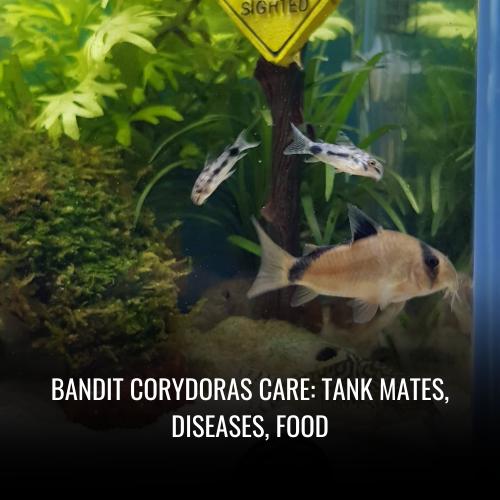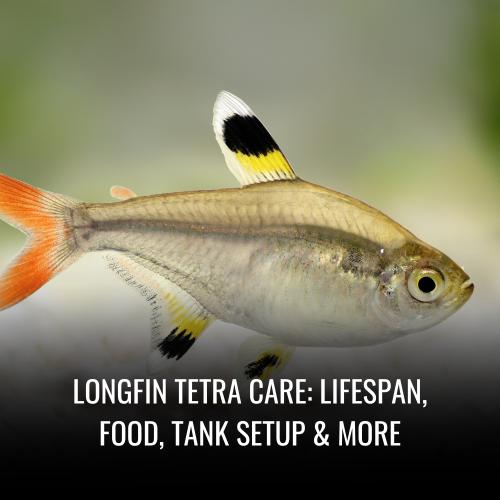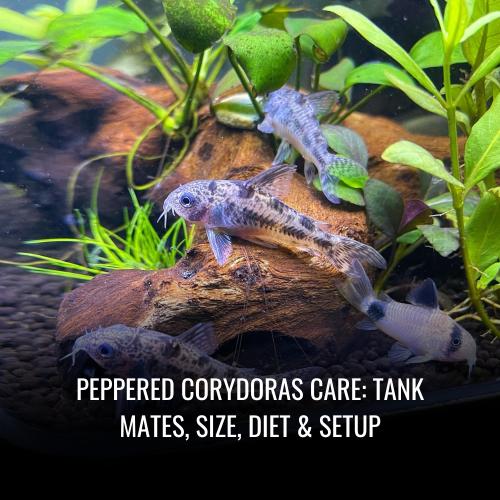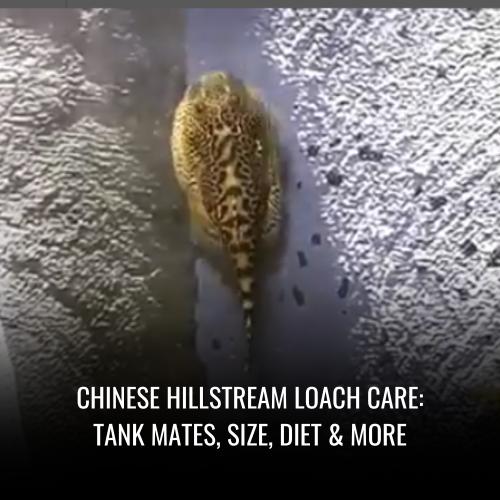Congo Tetra Care: Size, Tank Mates, Diet, Setup & More
This post contains affiliate links. As an Amazon Associate, we earn from qualifying purchases.
The Congo tetra, scientifically known as Phenacogrammus interruptus, is a beautiful freshwater fish that adds a splash of vibrant color to any aquarium. Originating from the central Congo River Basin, these fish are revered for their iridescent hues that dance across their bodies in a spectral light show.
Male Congo tetras are particularly striking, boasting feathery fins with delicate white edges that stand out against the murky waters of their natural habitat. When it comes to caring for Congo tetras in an aquarium setting, a few key considerations come to the forefront to ensure these stunning fish thrive.
| Scientific name | Congo Tetra |
|---|---|
| Common name | Congo Tetra |
| Family | Alestidae |
| Usual size in fish tanks | 3-4 inches |
| Recommended pH range | 6.0-7.5 |
| Recommended water hardness (dGH) | 5-15 |
| Recommended temperature | 75-82°F |
| The way how these fish reproduce | Egg layers |
| Where the species comes from (Origin) | Africa, Congo Basin |
| Temperament to its species | Peaceful |
| Temperament toward other fish species | Peaceful |
| Usual place in the tank | Mid to upper water column |
| Lifespan | 3-5 years |
| Tank size requirement | Minimum 20 gallons |
| Filtration system | Strong filtration recommended |
| Sexual dimorphism | Males have longer fins and more vibrant coloration |
| Substrate cleaning | Regular substrate cleaning is recommended |
Scientific Name
The scientific nomenclature for the Congo tetra is Phenacogrammus interruptus. This name reflects their distinctive markings and the environmental niche they occupy within the greater Characiformes order. They sit comfortably amongst other beloved fish in the Alestidae family, which consists of numerous species inhabiting Africa’s freshwater systems.
Average Size
Congo tetras are moderately sized fish, with adult males typically reaching up to 3 inches (7.5 cm) in length. Females are slightly smaller, averaging around 2.75 inches (7 cm). These fish require larger tanks to accommodate their active swimming habits and schooling behavior, with a 30-gallon tank recommended as a starting point for a small group.
Lifespan
In a well-maintained aquarium, a Congo tetra’s lifespan can range from 3 to 5 years. Several factors contribute to the health and longevity of these fish, including optimal water conditions, a varied diet, and stress-free surroundings. With diligent care, these fish may live towards the longer end of their lifespan.
Natural Habitat
The Congo tetra is a denizen of the flowing streams and still pools found within the Congo River system. Their natural environment is characterized by gentle currents, a mix of sand and mud at the bottom, and an abundance of aquatic plants. Congo tetras are used to swimming in schools, darting between plant leaves, and hunting for food in the rich, biologically diverse waters of their home. They thrive in settings that mimic these conditions, with plenty of plant life and soft substrates, and a tendency toward slightly acidic and dimly lit waters reflective of their native, vegetation-rich streams and marshes.
Appearance
Appearance The Congo Tetra is a captivating presence in any aquarium, thanks to its medium size and shimmering colors. Adult fish of this species can reach a length of up to 4 inches (10 cm), showcasing their elongated, slightly curved bodies and distinctive, expansive fins.
Males are the more flamboyant of the sexes, displaying magnificent, iridescent blue or silver bodies. This striking appearance is further highlighted by an orange stripe that runs longitudinally from the head to the caudal fin. The display is truly breathtaking when light strikes their bodies, accentuating the vibrant colors with an almost metallic luster.
Females, although more modest in their aesthetics possess their understated beauty. Their silver-gray bodies and lighter fins exude a soft, elegant glow, contrasting subtly with the bolder hues of the males.
Both sexes can have fins edged in white, adding a touch of class to their appearance. It’s the interplay of this iridescent and reflective coloration that makes the Congo Tetra a stunning fish, bringing a slice of the Congo River’s vibrant life into the tranquil environment of a freshwater aquarium.
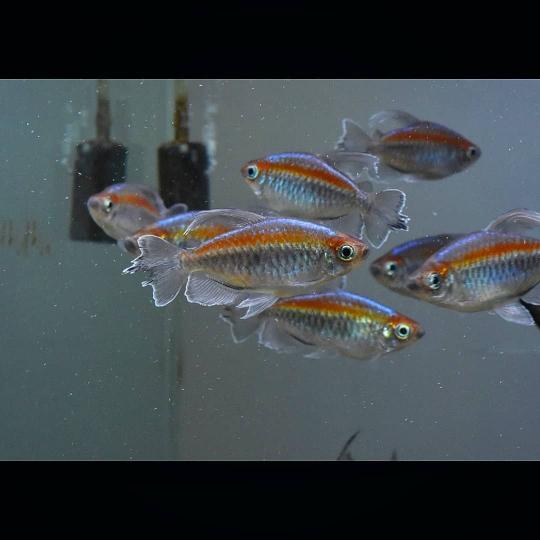
Behavior & Temperament
Congo Tetras are noted for their peaceful and sociable nature, which makes them an excellent choice for a community aquarium. In their natural habitat, they are accustomed to the calm, murky waters of the Congo River basin.
This preference for tranquility translates well to the home aquarium where they coexist harmoniously with similarly non-aggressive species. They are not known to be fin nippers or display aggressive behavior, provided they are placed in an adequately sized tank with plenty of swimming space that enables them to exhibit their natural schooling behavior.
A well-structured environment with dim lighting, dense vegetation, and driftwood can help mimic their native habitat, further promoting their docile temperament.
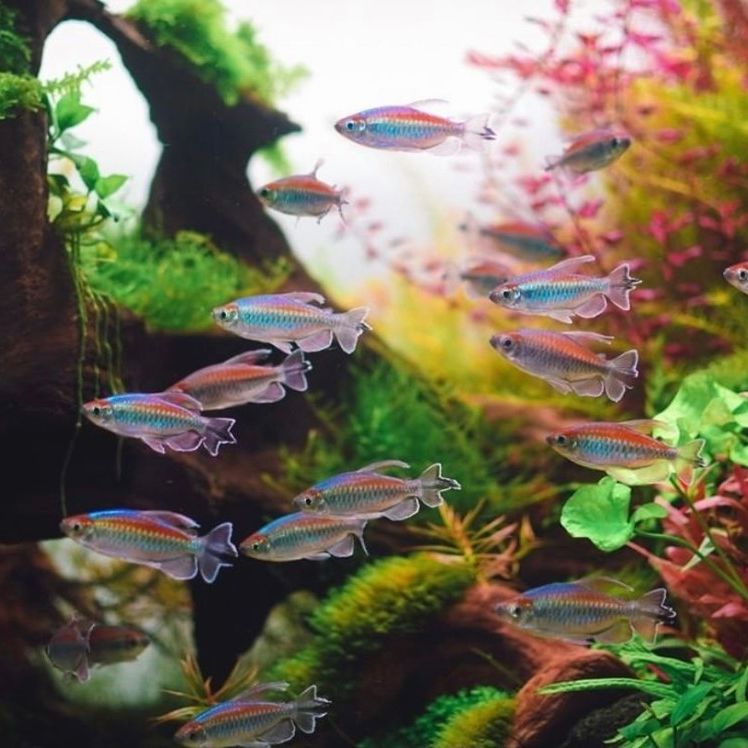
Are Congo Tetra Fin Nippers?
Congo Tetras are generally not fin nippers. They exhibit a placid demeanor that aligns with their striking aesthetics rather than aggression. Their long and delicate fins are more suited for display and complex swimming maneuvers, especially during courtship.
If they are given a varied diet and are housed in an environment resembling their natural habitat with appropriate schooling numbers, Congo Tetras are unlikely to display fin-nipping behavior. It’s crucial, however, to monitor feeding closely because underfeeding could lead to nipping as a sign of food competition.
Are Congo Tetra Aggressive To Each Other & Other Fish?
Within their social structure, Congo Tetras are more cooperative than combative. They tend to exhibit peaceful interactions with one another, particularly when housed in groups that reflect their natural tendency to school.
When it comes to tank mates, they can be housed peacefully with several other species that match their peaceful energy, such as other non-aggressive Characins, Rainbowfish, Corydoras catfish, and Dwarf Cichlids. Nonetheless, they should not be placed with aggressive fish or fish small enough to be considered prey, as this can lead to stress and potentially atypical behavior in Congo Tetras.
Are Congo Tetra Friendly To Each Other & Other Fish?
Congo Tetras are indeed friendly, both with their kind and with other serene tank mates who share their need for a mellow environment. For optimal welfare, they should be housed with fish that will not outcompete them for food or territory.
Compatibility is key in selecting tank mates to maintain the peaceful and harmonious setting these beautiful freshwater fish thrive. By providing a diverse and appropriate community, Congo Tetras can enlighten the tank with their radiant presence, contributing positively to the social dynamic.
Are Congo Tetra Schooling Fish?
Yes, Congo Tetras are quintessential schooling fish that show the best of their behaviors and health when maintained in groups. They find security and confidence within their schools, which typically consist of at least six to eight individuals.
Such groupings allow them to carry out natural behaviors like synchronized swimming and intricate social interactions. The school’s collective movement is not only a survival mechanism but also an enchanting spectacle that adds dynamism and brilliance to the aquatic setting.
Can You Have Just One Congo Tetra In The Tank?
Having just one Congo Tetra in the tank is not recommended. Isolation can lead to stress and a decline in both the physical and psychological health of these social fish. A lone Congo Tetra may exhibit duller colors, decreased activity levels, and reduced vigor. To avoid these issues and promote the overall well-being of these tetras, it is necessary to keep them in a group where their schooling instinct can be fully realized.
Do Congo Tetra Need To Be In Groups?
Group life is a fundamental aspect of the Congo Tetra’s existence. They thrive when in the presence of their conspecifics, with recommendations suggesting a minimum of six individuals to form a proper school. In a group, Congo Tetras experience lower stress, display more intense colors and are more resilient to environmental changes.
Without the comfort and protection of a school, individuals may succumb to stress-related conditions. Therefore, to foster a natural and healthy life for Congo Tetras, a group setting within their aquatic home is essential.
Food & Diet
Congo Tetras are versatile and opportunistic feeders with an omnivorous appetite that reflects their varied diet in the wild, comprising both plant and animal matter. In the home aquarium, offering them a diverse menu is essential to maintain their health and the splendor of their iridescent colors. A diet that includes high-quality dried foods, such as flakes and granules, should be the foundation, as these are convenient and balanced for daily nutrition.
However, to ensure they receive all the necessary nutrients and exhibit their vibrant colors fully, Congo Tetras benefit from supplemental feedings of live or frozen food like brine shrimp, daphnia, and bloodworms. These protein-rich options not only enrich their diet but also provide a feeding experience reminiscent of their natural foraging behavior. Vegetables, albeit in smaller amounts, can provide essential vitamins and offer some variety, contributing to their robust health and dazzling appearance.
Feeding should occur multiple times a day in small portions to prevent overfeeding and ensure that all individuals have access to food. Consistent with their natural feeding patterns, only offer an amount they can consume within three minutes. A meticulous feeding regimen not only sustains their health but also helps in managing water quality by minimizing waste.

Does Congo Tetra Eat Algae?
While Congo Tetras primarily feed on insects, worms, and crustaceans in their natural habitat, they have also been known to consume algae. In captivity, their diet should be supplemented with dried pellets or flakes that typically contain vegetable matter, which is sufficient to meet their nutritional needs, eliminating the necessity for algae as a food source.
Dedicated algae consumption is not a characteristic behavior of Congo Tetras; therefore, algae should not be relied upon as a significant part of their diet.
Does Congo Tetra Eat Shrimp?
Congo Tetras are particularly fond of brine shrimp, proving it to be an excellent choice for their diet. These shrimp offer an excellent source of protein and essential nutrients, contributing to the Congo Tetras’ well-being.
Incorporating live or frozen brine shrimp into their feeding routine not only enhances their diet but also encourages natural hunting behaviors and helps in maintaining their iridescent and vibrant colors. It’s important to balance their diet with these nutrient-dense foods to optimize their health.
Do Congo Tetra Eat Bloodworms?
Bloodworms are a very popular choice for Congo Tetras, as these worms are packed with protein vital to their growth and development. Including bloodworms in their diet is beneficial for maintaining their bright colors and overall health.
They can be served live or frozen, and they provide essential fatty acids that promote vibrant coloration and vitality. However, just like any other food, bloodworms should be a part of a varied diet to ensure Congo Tetras receive all the nutrients they require.
Does Congo Tetra Eat Mosquito Larvae?
Congo Tetras do indeed eat mosquito larvae, and these larvae can serve as a nutritious live food source that stimulates the fish’s natural foraging instincts. High in protein, mosquito larvae can enhance the growth, health, and activity levels of Congo Tetras in a captive environment. When provided as part of a balanced diet, mosquito larvae contribute to the diversity of the diet and ensure that Congo Tetras receive a range of essential nutrients.
Do Congo Tetra Eat Planaria?
Congo Tetras may occasionally consume planaria if they are present in their environment. However, it is important to stress that these flatworms should not be considered a main food source. To ensure proper nutrition, the diet of Congo Tetras must be well-balanced with a variety of proteins and essential nutrients obtained from commercial foods and other live food options, rather than relying on accidental consumption of organisms like planaria.
Do Congo Tetra Eat Plants?
Congo Tetras may sometimes nibble on softer, young plant leaves, which is a testament to their omnivorous nature. Yet, they are not typically destructive towards plant life, especially if provided with an appropriate diet that satisfies their nutritional needs. To prevent potential damage to live plants in the aquarium, offering a variety of food sources, including some vegetable matter, can help keep these stunning fish content and their environment intact.
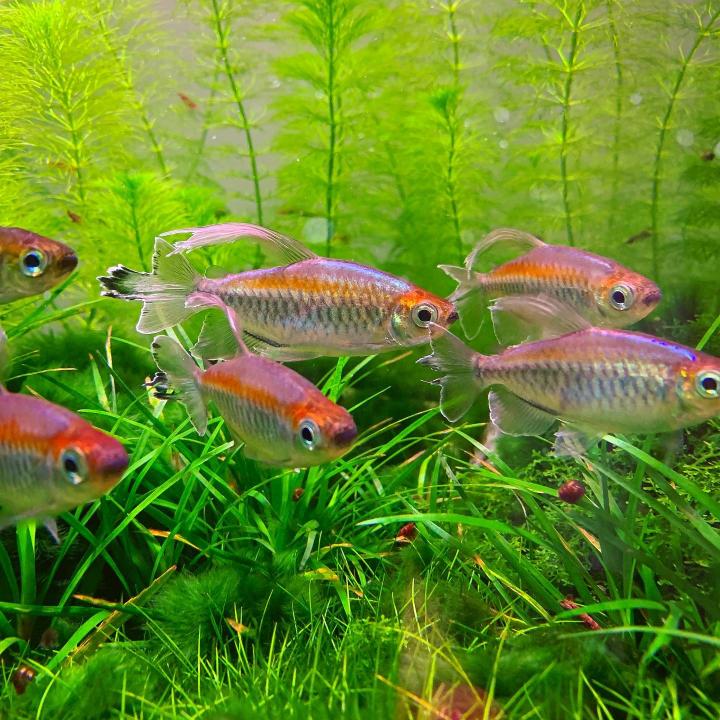
Sexing Congo Tetras: Male vs Female
Identifying the sex of Congo Tetras can be straightforward since both genders exhibit distinct physical differences.
Males are recognized for their larger size and boast an impressive array of iridescent colors that become particularly intense during the courtship ritual. Their fins are notably more extravagant, with elongated tails and dorsal fins adding to their display.
In contrast, females tend to have a subtler appearance with more rounded bodies and shorter fins. While their coloration is still pleasing, it lacks the vibrancy and iridescence of their male counterparts. When ready to spawn, female Congo Tetras gain a fuller, plumper look which can be noticeable from the side.
The table below outlines the primary differences:
| Trait | Male Congo Tetra | Female Congo Tetra |
|---|---|---|
| Size | Larger | Smaller |
| Fin Length | Long (tail & dorsal) | Short |
| Body Shape | Deeper, elongated | Rounder, plumper |
| Colors & Markings | Iridescent, vibrant | Less vibrant |
Understanding these differences is important for aquarists looking to breed or simply appreciate the intricate beauty of their Congo Tetras in a community tank setting.
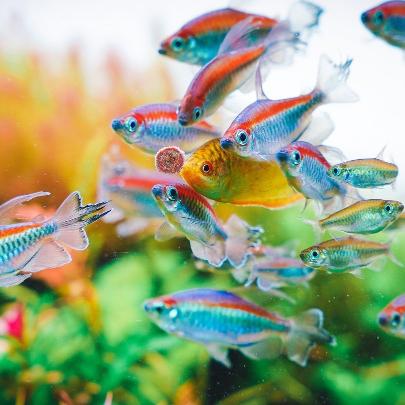
Congo Tetra Tank Mates: Peaceful Companions for a Harmonious Aquarium
In the diverse ecosystem of a community tank, Congo Tetras thrive alongside gentle and similarly sized fish. Exhibiting stunning iridescent hues, these beautiful freshwater fish are best housed in groups of at least six to foster a comforting school dynamic.
When considering tank mates, peaceful species are paramount to ensure the well-being of these schooling fish. Ideal companions include Neon Tetras, Corydoras, and Rainbowfish. Fish like Celestial Pearl Danios also make great company due to their passive nature.
To achieve a harmonious aquarium, be cautious of fin-nipping species. Congo Tetras possess flowing fins that may entice more aggressive fish, potentially causing stress or injury. Ample swimming space is not only a luxury but a necessity, with larger tanks being desirable. A 55-gallon long tank is the recommended minimum size to comfortably accommodate a school of 8-12 Congo Tetras, allowing these vibrant creatures to flourish and display their natural behavior.
Here’s a quick reference for suitable tank mates:
| Peaceful Tank Mates | Avoid |
|---|---|
| Neon Tetras | Aggressive fin-nippers |
| Corydoras | – |
| Rainbowfish | – |
| Celestial Pearl Danio | – |
Selecting tank mates mindful of these guidelines will create a serene and visually striking aquatic habitat for Congo Tetras.

Aquarium Setup
Creating the perfect setting for your Congo Tetras not only involves meticulous planning around tank size and tank mates but extends to other vital components of their environment such as water parameters, filtration, lighting, and substrate. Let’s delve into each of these aspects to ensure your Congo Tetras enjoy a habitat that comes as close as possible to their natural Congo River basin.
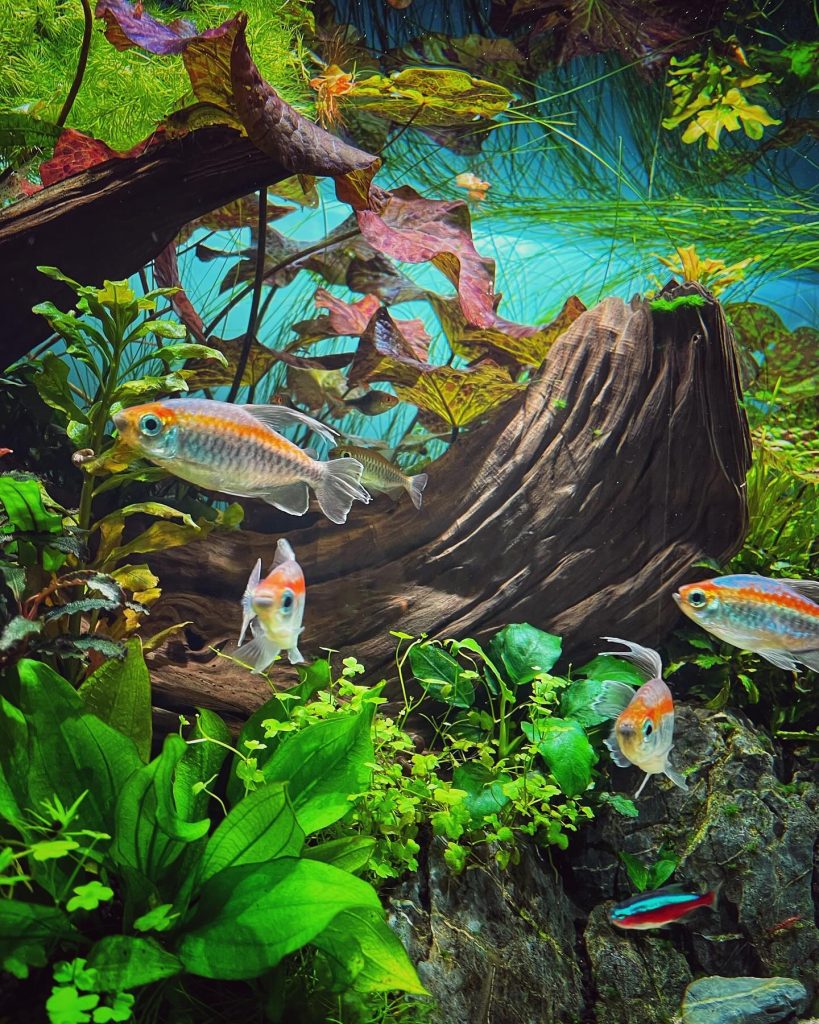
Ideal Tank Size
When it comes to housing Congo Tetras, space is more than just a luxury; it’s a necessity for their well-being. A 30-gallon tank is the quintessential starting point for these shimmering shoalers, providing ample room for a school to swim freely. While some aquarists may venture into keeping them in a 20-gallon setup, it’s not the most conducive to their social nature or need for swimming space. For those wishing to amplify their Congo Tetra’s habitat, larger tanks are not only favorable but encouraged. The expansion in size allows for a more substantial school, broader scope for themed decorations, and increased swimming territory, all of which contribute to the dynamism of your tank’s ecosystem.
Ideal Water Parameters
Congo Tetras flourish in water that mimics their natural environment. The temperature should remain steady between 73-82°F (23-28°C). As for the water’s acidity, a pH level of 6.0 to 7.5 is optimal, with a water hardness level (GH) ranging between 3-18 dH. Stability is key; fluctuations in these parameters can lead to stress and health complications for your fish. Invest in a reliable testing kit to faithfully monitor these conditions, ensuring the aquarium is always a sanctuary for your colorful companions.
Filtration
To achieve water quality worthy of your Congo Tetras, efficient filtration is non-negotiable. Filtration serves a threefold purpose: removing debris, fostering beneficial bacteria, and preventing the buildup of toxins. Considering the Congo Tetras’ sensitivity to water conditions, overfiltration might be more beneficial. A harmony of mechanical, biological, and chemical filtration is the ideal trio to maintain the pristine water they require. However, ensure that the current produced by the filter isn’t overpowering, as it would not reflect the gentle waters of their natural habitat. Regular upkeep of the filters, including cleaning or changing out filter media, is imperative for continual healthy living conditions.
Lighting
In replicating the Congo Tetras’ natural home in the shady margins of the Congo River, lighting should be subdued and indirect. Bright, direct lighting can lead to stress, hence affecting their vibrant coloration and activity. To enhance their iridescent spark, install soft lighting options that can be adjusted to recreate a dappled effect, similar to the sunlight that filters through the dense canopy overhead in their original riverine environment. Consider incorporating live plants that provide both coverage and the dimness Congo Tetras prefers for a more authentic feel of the Congo River’s murky ambiance.
In conclusion, a conscientious approach to tank size, water parameters, filtration, and lighting will go a long way in creating an environment that not only sustains but also enhances the well-being and natural beauty of your Congo Tetras. Remember to maintain a balance that encourages both health and happiness for these mesmerizing inhabitants of your aquatic world.
Common Possible Diseases & Prevention
Congo Tetras are enchanting but require vigilant care to stay healthy. The most prevalent disease they face is Ich, a condition exacerbated by stress and low temperatures. This malady appears as white spots and can be lethal, but with prompt isolation and treatment using commercial remedies, recovery is possible.
However, prevention is paramount. Consistent tank maintenance and watchful monitoring of water conditions are essential to ward off Ich and other diseases. Despite their resilience, Congo Tetras may succumb to skin flukes, bacterial infections, and parasites if their environment deteriorates or stress levels rise.
To safeguard your Congo Tetras from these threats, adhere to the following preventative measures:
- Regularly clean and maintain the tank.
- Quarantine new additions, including fish, plants, and decorations.
- Ensure stable, species-appropriate water temperature and quality.
- Minimize stress by providing ample swimming space and appropriate tank mates.
Remember, a healthy tank equates to a healthy Congo Tetras, thus preventing the spread of disease.
| Preventative Measure | Purpose |
|---|---|
| Tank Maintenance | Avoids disease-friendly conditions |
| Quarantine New Additions | Prevents introducing new pathogens |
| Stable Water Conditions | Keeps fish stress-free |
| Ample Space & Correct Mates | Promotes a tranquil environment |
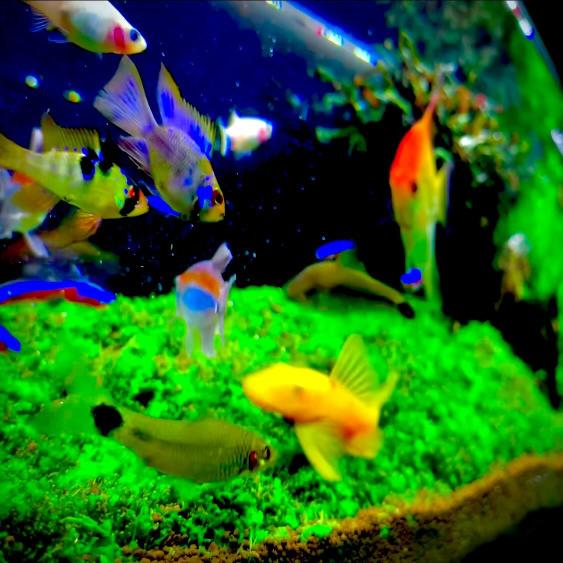
Breeding Congo tetra In Aquarium
Breeding Congo Tetras is a rewarding endeavor that requires attention to detail. To begin, a 20-gallon breeding tank is essential. Create an optimal spawning environment by laying a base layer of peat moss, which must be boiled beforehand to sterilize it.
Incorporate breeding plants and mops to encourage the spawning of bonded Congo Tetra pairs. Once spawning concludes, promptly transfer the adult fish back to the main tank. The eggs remain nestled in the peat moss, taking about 6 to 8 days to hatch.
Upon hatching, Congo Tetra fry thrive on infusoria, and as they grow, they gradually shift to baby brine shrimp and powdered fish food. Impressively, they can achieve nearly an inch in size within just two weeks.
The delicate fry necessitates specific tank conditions: soft and acidic water with a stable temperature of 77°F. Meanwhile, abstain from using aeration or filtration during this stage to prevent disturbance of the protective peat moss.
| Tank Requirement | Details |
|---|---|
| Size | 20-gallon |
| Substrate | Boiled peat moss |
| Temperature | ~77°F |
| Water Type | Soft and acidic |
| Additional Notes | No aeration or filtration |
Remember, these parameters are vital for successfully breeding and raising youthful Congo Tetras.
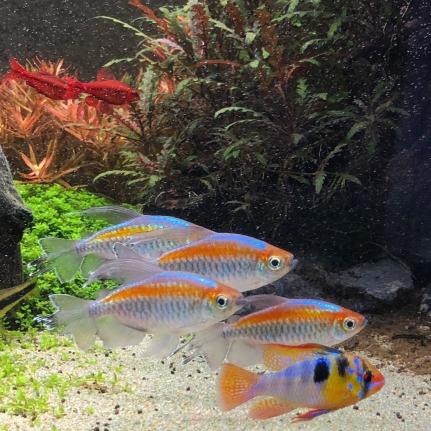
Is Congo Tetra Easy To Keep?
Congo Tetras are renowned as beautiful freshwater fish that offer a vibrant addition to any compatible community tank. Keeping them can be relatively straightforward, provided certain conditions are fulfilled to ensure their well-being. Stability in water quality is paramount, as is maintaining a clean tank environment with regular water changes. To keep Congo Tetras healthy and display their stunning iridescent colors, they require a water pH between 6.0 and 7.5 and a general hardness (GH) of 4-12.
Furthermore, these schooling fish are best kept in groups and need plenty of swimming space to flourish, so larger tanks are advisable. A tank size of at least 30 gallons is recommended to allow for adequate space and the development of a thriving planted environment that mimics their natural habitat in the murky waters of the Congo River.
Feeding Congo Tetras entails providing a varied diet, including high-quality flake foods, frozen food like brine shrimp, and occasional live foods to keep them in top condition. A consistent water temperature of 24-28 °C (75-82 °F) should be adhered to, avoiding sudden fluctuations that could cause undue stress. Both seasoned and novice aquarists find Congo Tetras satisfying to care for, thanks to their adaptability to a range of conditions, when basic care guidelines are consistently met.
Are Congo Tetra Sensitive To Water Changes?
Congo Tetras demand consistency in their aquatic environment. These fish exhibit heightened sensitivity to changes in water parameters, such as pH, temperature, and hardness. Sudden water fluctuations can inflict stress, triggering a spectrum of adverse effects, from diminished fin quality to a loss of their characteristic color vibrancy. Additionally, these changes can suppress their immune systems, potentially paving the way for disease.
Acclimating Congo Tetras slowly and with care to any new water conditions is crucial. This caution is particularly important when introducing them to a new aquarium or during routine water changes. Their care regimen must include frequent water testing and the implementation of a proper filtration system to maintain stable water conditions. When water parameters need adjustment, a gradual approach is best to safeguard the welfare of Congo Tetras in the aquarium.
Are Congo Tetra Sensitive To Ammonia?
Ammonia sensitivity is a critical aspect of Congo Tetra care. Even low concentrations of ammonia can inflict substantial stress, impairing their delicate gills and hindering respiration. In turn, the fish may become lethargic, lose interest in food, and become more susceptible to infections. A spike in ammonia can upend the aquarium’s fragile ecosystem, constituting a grave threat to Congo Tetra’s health.
To avert ammonia-related issues, diligent water testing and consistent tank maintenance are indispensable. Occurrences of ammonia spikes necessitate prompt action—a swift water change coupled with the introduction of beneficial bacteria is imperative to neutralize the threat and maintain an environment conducive to the health of Congo Tetras.
Is Congo Tetra Sensitive To Copper?
Congo Tetras exhibits a particular sensitivity to copper. This metal—commonly utilized in various fish medications—poses a toxic risk to Congo Tetras, potentially leading to heightened stress, illness, or even mortality. Since tap water can often contain traces of copper, it is essential to treat the water with conditioners designed to remove copper before adding it to the aquarium.

